The defeat of the Austro-Hungarian armies in the battle of Gorodok
After the occupation of Galich and Lviv in the Battle of Galicia, a radical change occurred (Galich-Lviv operation). The north wing of the South-Western Front (4-I, 5-I armies and the approaching 9-I army) launched a counterattack. Austro-Hungarian troops began to withdraw. The Austrians failed to stop the Russian troops on the southern flank of the front, where the Austro-Hungarian 4, 3 and 2 armies tried to defeat the Russian 3 and 8 armies. Gorodok battle was lost Austro-Hungarian troops. The Austro-Hungarian command was forced to begin the withdrawal of all the armies of the river. San Russian troops pursued the enemy until September 21 and laid siege to the fortress of Przemysl. As a result, the Russian army won the strategic Galician operation.
The victory of the Russian troops in the Battle of Galicia destroyed the German-Austrian plans on the Eastern Front. Hope to end the Russian army with mutual attacks of Austrians from Galicia and Germans from East Prussia was destroyed. Moreover, there was a threat of invasion of Russian troops in Silesia and Hungary.
Plans of the Russian command
On September 3 a new 4 Army was formed under the command of Platon Alekseevich Lechitsky from the corps of the 9 of the Russian army and the reinforcements arrived. The 18 and 14 corps, the Guards Rifle Brigade and the 13 Cavalry Division entered the new army. Lechitsky was a military general who had a Chinese march (iheethuan uprising) and the Russo-Japanese war behind his shoulders.
All the armies of the South-Western Front were ordered to go on the offensive and drop the enemy to the Vistula. The army of Lechitsky, located on the right flank of the front, in the region north-west of Lublin, was given the task of advancing on Jozef, between the rivers Bystrica and the Vistula.
The 4 Army under the command of Evert, which included the 16 and Grenadier Corps, was reinforced by the Guards and 3 Caucasian Corps. In addition, it included a strong cavalry grouping - a separate guards cavalry brigade, 3-I Don and Ural Cossack divisions. The army of Evert was to be at the front of the town of Bykhava - Por river to develop an offensive on the Krasnik direction.
The 5 Army Plehve in the previous composition attacked Turobin and Krasnobrod. With its right flank, the 5 Army was to support the 4 Army in the area of Torzhkov and Zholkevka. The 3 Army of Ruzski, with its right flank, was to develop an offensive along the Tomashov-Belgorai line. A little later, when the news came about the capture of Lviv, the Russian army also received the task of attacking the Yaroslavl direction. Brusilov's 8 Army was advancing on the Lviv direction and along the Dniester, receiving instructions to act on the situation.
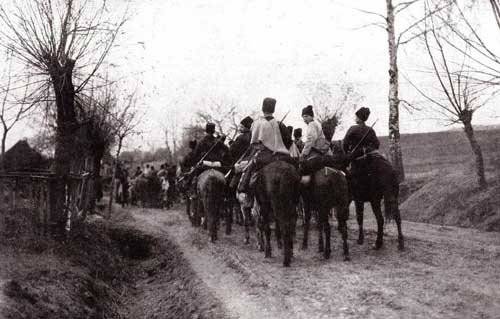
Russian Cossacks enter the village. Galicia. World War I
Austrian Command Plans
After the fall of Lviv, the Austro-Hungarian command decided to shift the focus to its southern flank. According to the Austrians, the Russian 4-I and 5-I armies suffered a heavy defeat, retreating to the line Lublin-Hill and did not pose a threat. Therefore, the 4 Army of Auffenberg, which acted against the Russian 5 Army, was sent to Lviv. Against 5, the army was left behind by a small grouping of Joseph-Ferdinand, which was supposed to "pursue" the Russians.
Thus, the Austrian 3 army was to take a strong, prepared City position, and to pin down the Russian 3 and 8 army from the front. At this time, the Austrian 2-I and 4-I armies were supposed to inflict covering attacks from the flanks. 2-I army concentrated in the area of Sambir, Komarno, Drohobych. The 4 army was to strike the right flank of the 3 Russian army, advancing in the general direction on Nemirov, Magiruv. At this time, the 1 Army had to conduct defensive operations in the Lublin sector.
Source: Kolenkovsky A. The Maneuverable Period of the First World Imperialist War 1914
Counteroffensive of 5, 4 and 9 of Russian armies
September 4 went on the offensive 5-I army Plehve. The right flank of the 5 Army (25 Corps), in cooperation with the left flank of the 4 Army, defeated the Austro-Hungarian troops in the area of Zholkevka. Captive took about 1600 people. Thus, the armies of Plehwe and Evert established a direct connection. The remaining three corps of the Plehve army (19, 5, and 17) went to the Skersbesh-Hrubieshov line. Unfortunately, the army command could not immediately form a mobile group from the four existing cavalry divisions to pursue the enemy. Cavalry divisions were distributed among the army corps.
The 4 and 9 armies did not achieve decisive success. They moved very slowly. Basically, the troops of the 9 Army were advancing. For the previous period, Austro-Hungarian forces created strong defenses in the Lublin area and often turned into strong counterattacks. However, the success of the X-NUMX Army Plehve on the Austrian right flank led to the fact that the stability of the defense of the X-NUMX Austrian Army began to crumble.
The Austro-Hungarian command, concerned about the need to maintain the link between the 1 army and the 4, 3 and 2 armies, tried to strengthen the right flank of Dunkl's army. Kummer's corps was already used in the battles on the left flank of the 1 Army. Therefore, there remained only the German corps of Voirs. The September 4 Corps forced the Vistula, went out to Janov and Frampol, and from there it was sent to Turobin and then to Tarnavka, where September 7 engaged the Russian troops.
Plehve's army continued to oppose the group of Joseph-Ferdinand. September 6 parts of the 19 Corps captured Zamo Замć. The army entered the line Zamoостьć - Zubovice. Only now, realizing that before them only the weak parts of Joseph-Ferdinand, did the command form a group of three cavalry divisions under the command of General Dragomirov to advance in the general direction of Belgorai and conduct wide reconnaissance towards the San.
September 6 front command, taking into account the changing situation, gave the armies a new introductory. The 9 Army had to develop an attack on Jozef, then force the Vistula and move on Opatov and Sandomierz. 4-I army, developing the emerging success on the left flank, was given the task of dropping the enemy to the Vistula. The 5 and 3 armies were to develop a frontal attack. 8-th army left the old task - to act on the Lviv direction.
On September 7, the right-wing 25 Corps of the 5 Army, after receiving information about the movement of large enemy forces in the area of Goray-Turobin, went over to defense. Russian troops entrenched themselves on the Zhovkivka-Kitov line. The 19 body is somewhat advanced from Zamoć. The 5 and 17 corps continued the offensive, took Kotlice and the crossings to the r. Guchve near the villages of Vakiyev and Tyshovtsy. An 900 man was captured.
9-I and 4-I armies also oppressed the enemy, knocking him from the fortified positions. As a result, Russian troops established themselves on the Yanushev - Bystritsa - Kosarzhev line. It must be said that, despite the considerable concentration of troops and artillery, it was difficult to penetrate the enemy defenses. The war has already begun to take a positional character. With large losses and a large expenditure of projectiles, the offensive developed slowly. Frontal attacks of enemy positions, without roundabout maneuvers from the flanks, brought their negative results. For example, on September 7, such a battle in the Romanov and Tarnavka areas was conducted by troops of the Guard and Grenadier Corps with the support of the left flank of the 16 Corps of the 4 Army. The 12 2 / 1 corps and their artillery - 2 light guns and 240 howitzers were concentrated on the 24-kilometer front area. As a result, one division accounted for 2 1 / 2 km of front and 22 guns on 1 km of front. However, despite such favorable conditions, the offensive developed slowly.
September 8 5 Army troops continued to develop the offensive. The 25 Corps successfully shot down the enemy from a fortified position on the line of the villages Zhurave - Zalozhtsa. The 19 Corps captured ferries on the Veprezh River, from Detkovice to Bodachev. The 5 and 17 corps also oppressed the enemy. The horse group of Dragomirov crushed the enemy’s rear, his carts in the Krasnobrod and Frampol area.
On the same day, the troops of the 4 and 9 armies advanced more successfully. The Grenadier, Guards, 3 Caucasian corps were stormed by the well-fortified positions of the Austrian and German Landwehr corps of the Voirsh 5 on the Pavlov-Daragan line. Initially, despite strong artillery preparation, the offensive developed slowly. The troops suffered heavy losses from enemy fire and lay down before reaching the Austrian trenches. Only on the southern flank of the battlefield, parts of the 3 Caucasian Corps, together with the Guard and the 82 Division's brigade from the south, took the villages of Vysoke and Daragan. But as night fell, the Guards regiments were able to catch the landshare part of Voirsch by surprise (the Germans, who did not have camping stoves, started cooking). The Germans were defeated and lost 30 guns.
9-I army went on the offensive from the Vistula to Bystrica, and by the end of the day the right flank broke through the Austrian defense. Russian troops took to the line Kopanino - Years. On this day, Lechitsky's troops captured about 2 thousand prisoners with guns and machine guns. Thus, 8 September was marked by a radical change in favor of the Russian armies on the right wing of the South-Western Front.
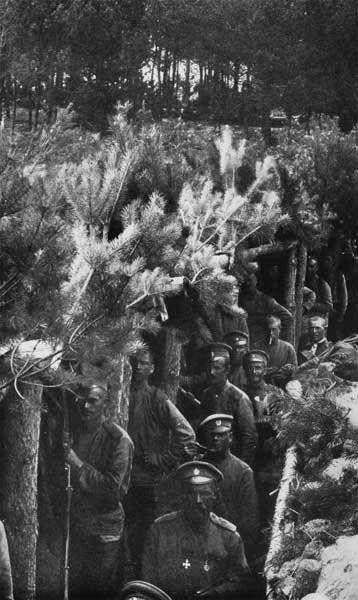 Continuation of the offensive
Continuation of the offensive9 September, the turn in the battle finally came. The German corps of Voirsha was finished off, as a result, the front of the Austrian 1 army was broken through. The battle at Tarnavka ended with the victory of the Russian troops. 10 - September 12 The 4 and 9 armies were pursued by the retreating enemy forces. The Austrians suffered great losses in battles and lost heart.
The Austro-Hungarian command, due to the failures of the 1 Army on the left flank and the defeat of its right flank, began to withdraw troops that could get surrounded if they continued to resist in the remaining positions. As a result, Dunkl's army ceased to perform the role of a barrier that Russian troops had to hold back until the 4, 3, and 2 armies were won up in the Gorodok battle. Although the Austrian command still hoped to bring the 1 th army in order and detain the Russian troops north of the Tanev forests.
The troops of the 5 Army after the victory at Tarnavka were divided into two groups. Right flank corps (25 and 19) attacked Goraets and Goray to cover the right flank of the Austrian 1 army. The left flank of the army (5 and 17 of the corps) defeated the enemy from Tomashev (many prisoners and 14 guns were captured) and entered the Paseki-Nedezh line. On September 10, the commander of the 5 of the Russian army received an order from the front to send the left-flank corps to the rear of the enemy rava-Russian grouping (the 4 of the Austrian army). Russian troops were to attack on the line Narol - Tseshanuv.
On September 11, the right flank of the 5 Army entered the Goray - Frampol - Comt line, the left flank - Nove Selo - Brusnu. Dragomirova's cavalry occupied the Tseshanuva region and, on the way to Oleshytsia, ran into the Austrian cavalry corps of Ziegler. As a result, the army of Plehve went to the left flank of the Austrian 4. September 12 Russian troops continued to move and created a serious threat to the flank and rear of the Austro-Hungarian army. The Austro-Hungarian command had to bend the left flank of the army from Rava-Russkaya to Gorinets, and then begin a retreat.
Gorodok battle
While on the right wing of the South-Western Front, the 9-I, 4-I and 5-I armies penetrated the enemy defenses, on the left-wing 3-I and 8-I armies also fought hard with the enemy. 3-I army after the occupation of Lviv continued the offensive. Ruzskoy sent the right-flank 21 corps to the area of the settlements of Varenzh and Belz, moving closer to the troops of the 5-th army. The rest of the corps took to the line Butyn - Waldorf - Stradch. At the same time, the forces of Brusilov's 8 Army came to the front of the Wroclaw-Szherzhets right-wing flank. And the left flank of Brusilov’s army advanced on Mikolaev.
The Austro-Hungarian command already knew about the strengthening of the Russian Lublin-Kholm group and the transition of the 1 Army to a tough defense. Therefore, it was necessary to launch an offensive on the Lvov direction as soon as possible. September 6 The 4-I army received orders to go to the Staržisk-Zolkiew line, and the 2-I army to the Cherlan-Salonka line. The 2 Army was instructed, after the success of the 4 Army, to attack south of Staržiska. In addition, they planned to form a strong cavalry group on the left flank of the 4 Army. Thus, the oncoming battle of the Austrian and Russian armies began.
September 6 began fighting in the area of Rawa Russkaya and Magiruva. Here, the right flank and the center of the Ruzsky army were attacked by superior enemy forces. On the night of September 8, Brusilov's army took on a strong enemy stronghold on the Dniester - Mykolaev. The city was captured 6 guns. This success ensured the southern flank of the common front of the 40 and 3 armies.
September 7 army Ruzskogo led heavy battles on all its front. In Radostav and Veal, the Russian 21 Corps defeated part of the Joseph-Ferdinand group. Several hundred prisoners were captured, 18 guns and more. weapon. As a result, the offensive of the left flank of the 5 Army was clothed, and the opportunity arose to grip the left flank of the Austrian Army 4. On this day, the 8 Army fought on its right flank with units of the Austrian 3.
The Austro-Hungarian command, taking into account the threat to the left flank of the 4 Army, took a number of measures. So, the Joseph-Ferdinand group was attached to the 4 Army. The 3 army was supposed to support the 4 on its right flank. The 2 Army received increased pressure on the left flank of the Russian front, advancing on Lviv.
September 8 heavy fighting between Russian and Austro-Hungarian troops continued. Particularly stubborn battles were fought at the junction of the 3 and 8 of the Russian armies. On the site of Vyshenka, Lelehovka, where the onslaught of the Austro-Hungarian troops was particularly strong, three cavalry divisions had to be thrown. The cavalry was ordered to stop the enemy. At the same time the Austrian 2-I army tried to break through the defense of the army Brusilov. The left-flank formations of the Austrian army reached the line of Stavchany, Humenets, and the right flank broke through at Tershakov and Kolodruba.
September 9 battle continued. The right wing of the army of Ruza unsuccessfully attacked the Rava-Russian. The troops of the center fought in the Magiruva area. The left flank of the 3 Army could hardly withstand the attacks of the enemy. But especially fierce battles were still going on at the junction of the two Russian armies. At around noon, she began to breach Dombrovitsa. Three Russian cavalry with great difficulty restrained the onslaught of the Austro-Hungarian troops. However, in the evening, parts of the 10, 12, and 7 bodies were transferred to this direction. The threat of a breakthrough has been eliminated. Russian troops strengthened the defense at the junction of the two armies. On the rest of the front, although the Austrians have made some progress in some places, in general, their strikes were reflected. Both sides suffered significant losses in these fierce battles. The Austrians ran out of steam.
September 10 Ruzsky army continued the attack on the Rav-Russian direction. The right-flank 21 corps was aimed at bypassing the enemy grouping, at Verkhrat. The army of Brusilov also attacked on the whole front and led heavy battles east of Gorodok. The next day, the fighting continued without much success.
On September 12, the Austrian command began to withdraw troops from Rabbi-Russian direction, fearing that the left wing of the 5 Army Plehve would go to the rear. The 21 Corps of the 3 Army occupied Grebenna and Verhrat. For some time the Austrians still resisted in the Vyshenka area. However, they soon began to retreat before the entire front of the army of Ruzsky. Russian troops captured 9 thousand prisoners, 30 guns, a lot of other weapons and supplies only in the area of Rava-Russkaya. Austro-Hungarian troops ran in front of Brusilov’s army. The advanced units of the 8 Army entered the line Sadov-Vishnya, Ostrozhets and Konyushki.
Thus, the three Austrian armies in the oncoming Horodok battle could not defeat the troops of Ruza and Brusilov. The fierce repulse of the Russian troops, which repulsed all enemy strikes and continued to develop the offensive in some directions, as well as the situation in the Lublin-Kholm direction, when the troops of the 5 Army began to go to the flank and to the rear of the 4 Austrian army, forced the Austro-Hungarian Army start a general retreat.
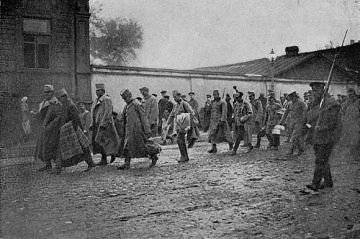 Austrian Army Retreat
Austrian Army RetreatThe command of the Russian South-Western Front attempted to organize the pursuit of the enemy with the aim of encircling and destroying its main forces. However, all the activities of the Russian armies could no longer lead to the enemy’s encirclement. The Austrian command began the withdrawal of troops in a timely manner, even 11 September, before the end of the Gorodok battle. The chief of the Austrian General Staff, Konrad von Gettsendorf, ordered the battle to be stopped and troops to be withdrawn across the San River.
In addition, the Russian troops were very tired, and there was simply no way to carry out a new deep operation to pursue the enemy. September 16 Russian troops were stopped for rest, replenishment and rear equipment. Especially needed troops in ammunition. Before the war, they had no idea that the consumption of ammunition would increase so much. This allowed the Austro-Hungarian armies to break away from the Russians, to avoid complete defeat and to put themselves in order.
Austrians 16 September reached Sana. In Yaroslav and Peremyshl strong garrisons were left. 17 September Austro-Hungarian troops began to retreat to the Dunajec River. By 26 September, the Austrian-Hungarian forces were in the following positions: 1 Army on the Boleslav line (on the Vistula River) - Tukhov, 4 Army on the Tukhov line - Biech, 3-I Army - Beech - Zboro and 2-I army from Swidnik to Uzhokskiy pass in the Carpathians, where the Karg group was located.
Russian troops continued to move. 9-I army went to the river Visloku from Klishuva to Kolbusheva. 4 th army was transferred to the reserve and transferred to the Ivangorod direction. 5-I army crossed the river San, stormed Yaroslav took and went on the line Grodzisko - Pantalovitsa. The 3 Army of Ruza laid siege to the strong fortress of Przemysl. The advanced units of the army Brusilov came to Dobromil and Potok. Ahead of the armies were reconnaissance 8 cavalry divisions.
General results
The Galician operation ended in complete victory for the Russian army. Austro-Hungarian troops were defeated and retreated. However, the plans of the Russian command to encircle and destroy the main forces of the Austrian army were not implemented. Austrian troops ousted from Galicia, but not completely defeated. The exhaustion of the Russian armies towards the end of the operation led to the fact that the Russian command temporarily halted the offensive, which allowed the enemy to calmly withdraw to the r. Dunajec and create a stable front.
The plans of the Austro-Hungarian command to invade the Russian lands were destroyed. In addition, the Austro-Hungarian Empire could not inflict a military defeat on Serbia, moreover, the Austro-Hungarian troops suffered a heavy defeat on the Serb front in the 1914 campaign of the year (Serbian front of the First World War; The defeat of Austria-Hungary in the Serbian campaign 1914 of the year). The Austrian command was forced to transfer considerable forces against Russia, which were intended for the quick defeat and occupation of Serbia.
The battle lasted more than a month. During this time, the Russian army advanced on 280 — 300 km. Austro-Hungarian troops lost more than 400 thousand people, including 100 thousand people prisoners and 400 guns. The losses of the Austrian armies accounted for almost half of all the troops in cash, on average in each division they lost 7,5 thousand people. Russian troops lost about 230 thousand people, including about 40 thousand people prisoners (on average 4,5 thousand people per division), as well as about 100 guns.
Russian troops occupied the ancient Russian region of Galicia, as well as liberated part of Austrian Poland. The threat of invasion of Hungary and Silesia was created. The Austro-Hungarian army lost the ability to independently deter the offensive of the Russian army. This worsened the position of the Central Powers. Vienna, given the temporary loss of combat capability of the army, even hesitated. There was a question about the possibility of continuing the war. Berlin had to make great efforts to save the main ally to continue the war.
Given the East Prussian operation, the German command was forced to transfer considerable forces to the Eastern Front. This eased the position of the French and British troops on the Western Front. In addition, the plan of the German command to defeat the Russian army was thwarted by coordinated strikes from East Prussia and Galicia and a quick end to the war on the Eastern Front (this operation was planned to be carried out after the defeat of France). Austria-Hungary could no longer fully support the German offensive.
Sources:
White A.S. Galicia battle. M.-L., 1929 // http://www.grwar.ru/library/Beloy-Galicia/index.html.
Zayonchkovsky AM World War I. SPb., 2002.
Zalessky K.A. Who was who in the First World War. M., 2003.
Kersnovsky A. A. History Russian army. M., 2006.
Kolenkovsky A. Maneuvering period of the first world imperialist war 1914, M., 1940.
Rostunov I.I. The Russian Front of the First World War. M., 1976. // http://militera.lib.ru/h/rostunov_ii02/index.html.
Utkin A.I. The First World War. M., 2001 // http://militera.lib.ru/h/utkin2/index.html/
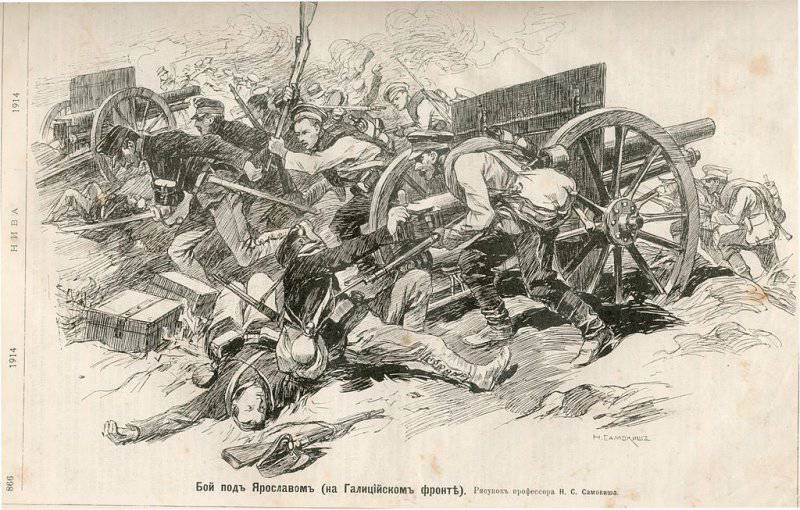
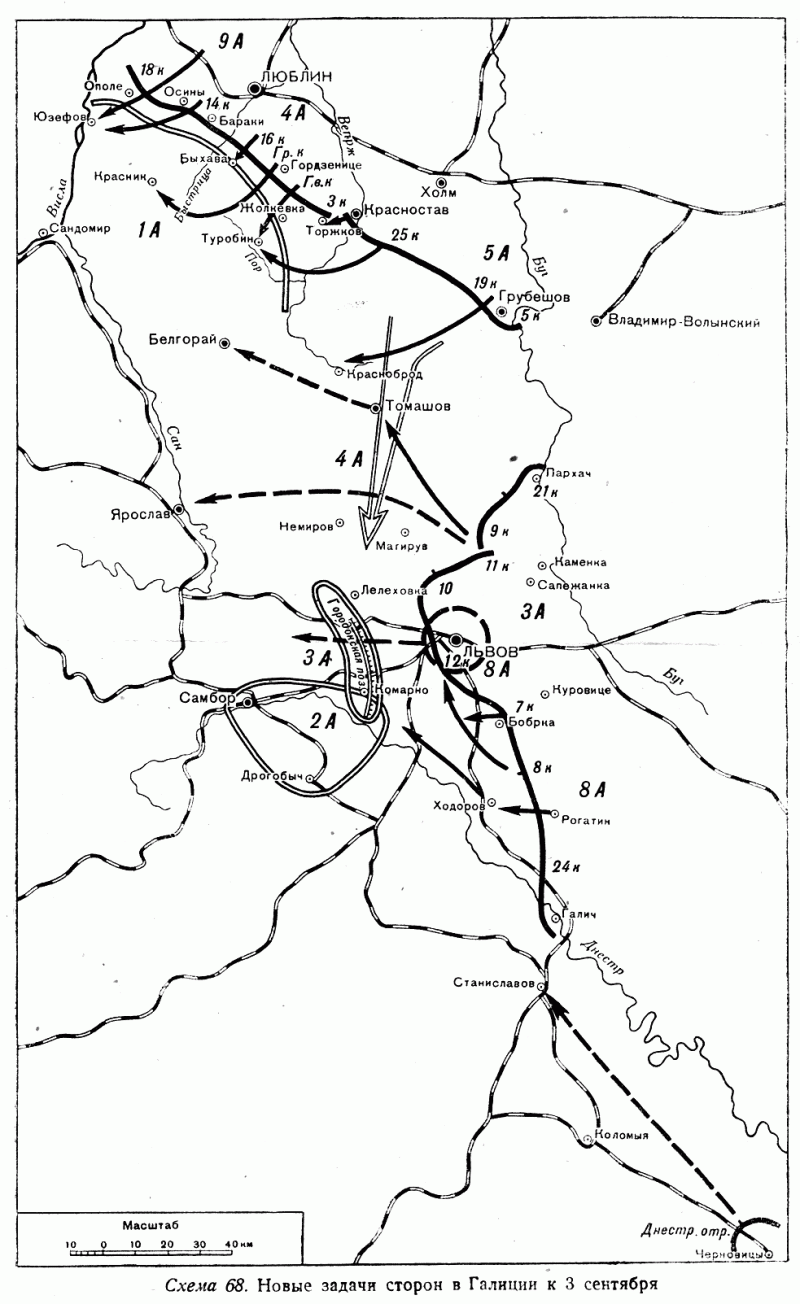
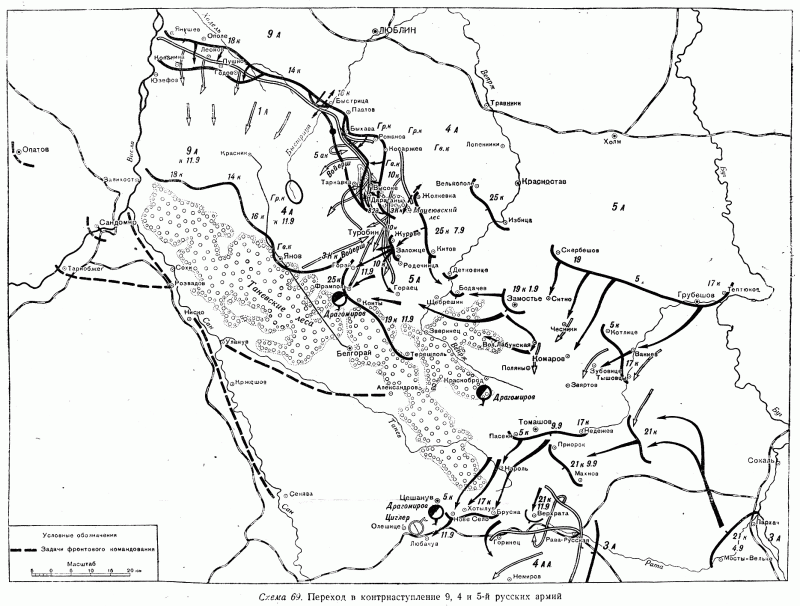
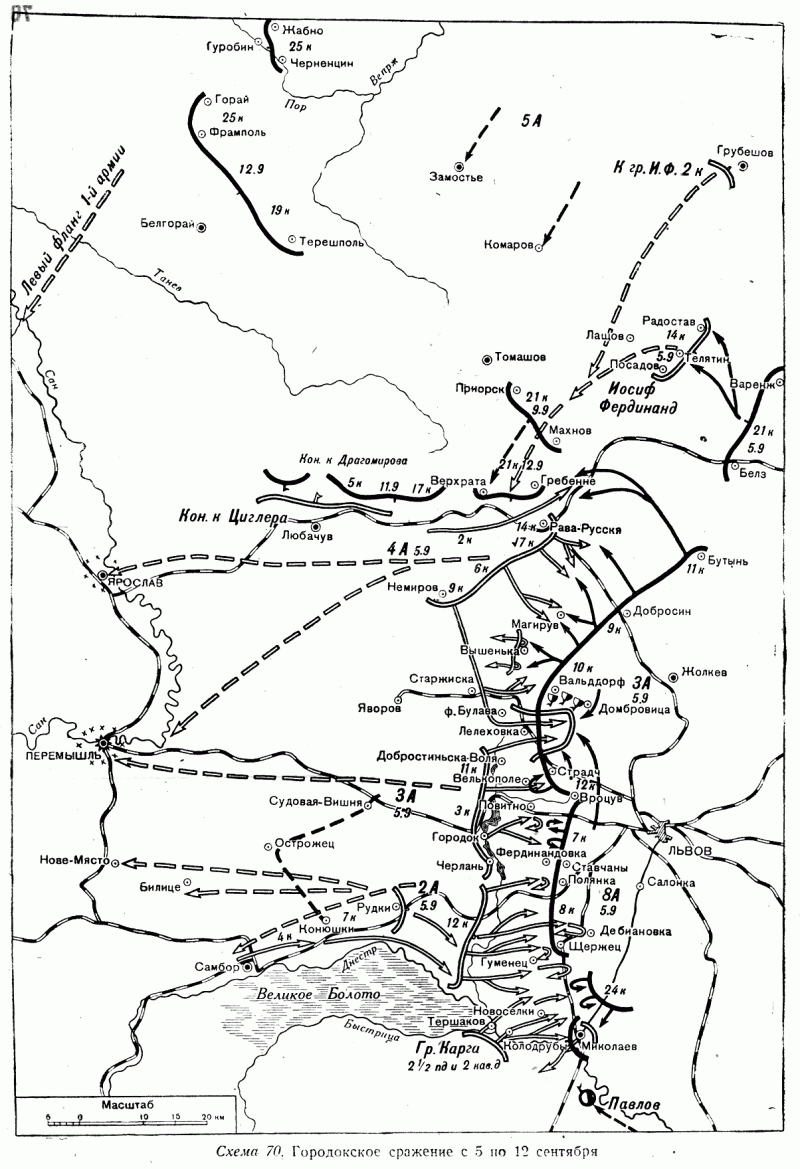
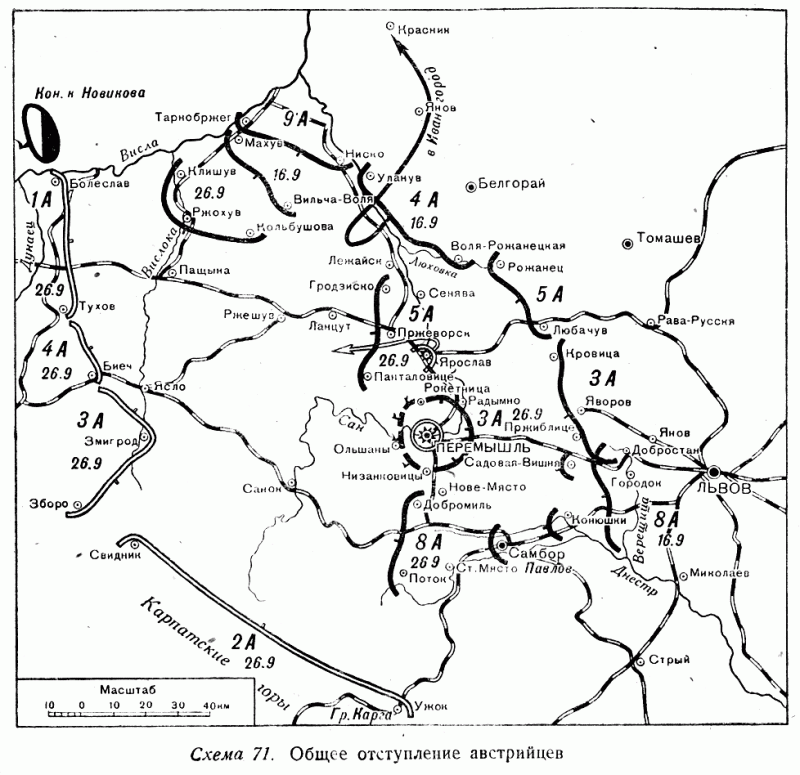
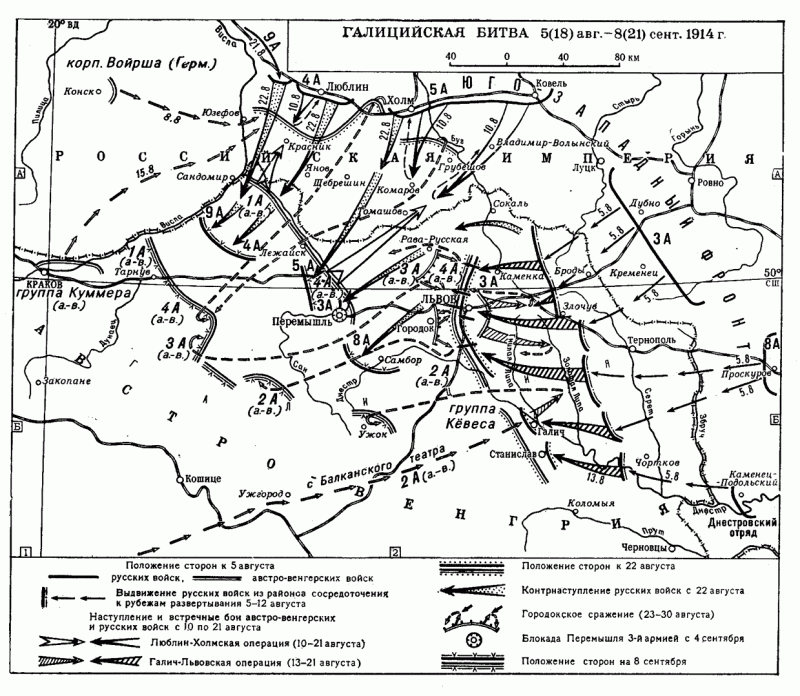
Information